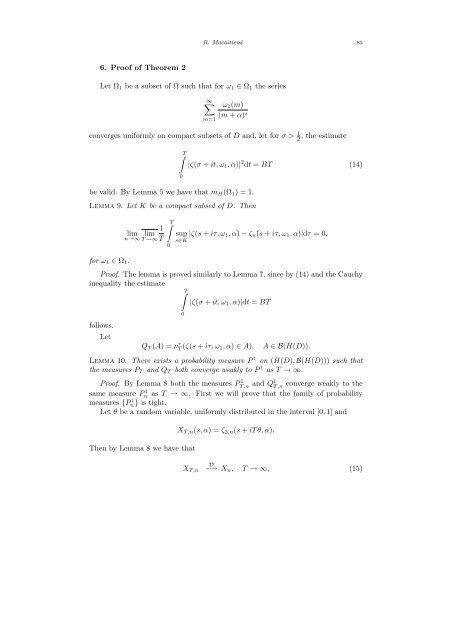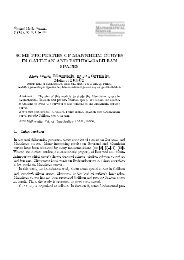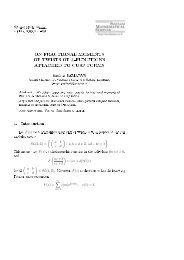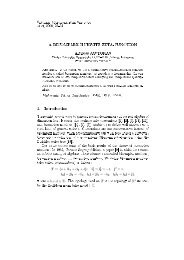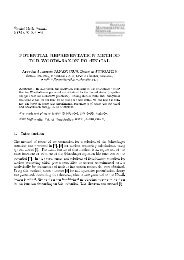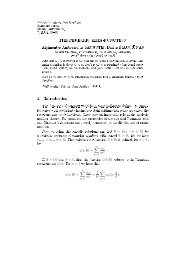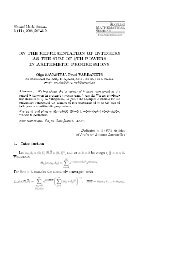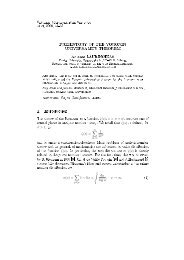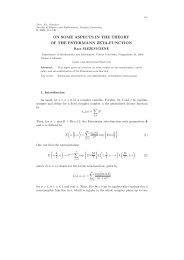a limit theorem for the hurwitz zeta-function in the space of analytic ...
a limit theorem for the hurwitz zeta-function in the space of analytic ...
a limit theorem for the hurwitz zeta-function in the space of analytic ...
Create successful ePaper yourself
Turn your PDF publications into a flip-book with our unique Google optimized e-Paper software.
R. Macaitienė 85<br />
6. Pro<strong>of</strong> <strong>of</strong> Theorem 2<br />
Let Ω 1 be a subset <strong>of</strong> Ω such that <strong>for</strong> ω 1 ∈ Ω 1 <strong>the</strong> series<br />
∞∑<br />
m=1<br />
ω 1 (m)<br />
(m + α) s<br />
converges uni<strong>for</strong>mly on compact subsets <strong>of</strong> D and, let <strong>for</strong> σ > 1 2<br />
, <strong>the</strong> estimate<br />
be valid. By Lemma 5 we have that m H (Ω 1 ) = 1.<br />
Lemma 9. Let K be a compact subsed <strong>of</strong> D. Then<br />
<strong>for</strong> ω 1 ∈ Ω 1 .<br />
lim<br />
lim<br />
n→∞ T →∞<br />
1<br />
T<br />
∫ T<br />
0<br />
∫ T<br />
0<br />
|ζ(σ + it, ω 1 , α)| 2 dt = BT (14)<br />
sup |ζ(s + iτ, ω 1 , α) − ζ n (s + iτ, ω 1 , α)|dτ = 0,<br />
s∈K<br />
Pro<strong>of</strong>. The lemma is proved similarly to Lemma 7, s<strong>in</strong>ce by (14) and <strong>the</strong> Cauchy<br />
<strong>in</strong>equality <strong>the</strong> estimate<br />
∫ T<br />
follows.<br />
Let<br />
0<br />
|ζ(σ + it, ω 1 , α)|dt = BT<br />
Q T (A) = ν τ T (ζ(s + iτ, ω 1 , α) ∈ A),<br />
A ∈ B(H(D)).<br />
Lemma 10. There exists a probability measure P 1 on (H(D), B(H(D))) such that<br />
<strong>the</strong> measures P T and Q T both converge weakly to P 1 as T → ∞.<br />
Pro<strong>of</strong>. By Lemma 8 both <strong>the</strong> measures PT,n 1 and Q1 T,n converge weakly to <strong>the</strong><br />
same measure Pn 1 as T → ∞. First we will prove that <strong>the</strong> family <strong>of</strong> probability<br />
measures {Pn} 1 is tight.<br />
Let θ be a random variable, uni<strong>for</strong>mly distributed <strong>in</strong> <strong>the</strong> <strong>in</strong>terval [0, 1] and<br />
Then by Lemma 8 we have that<br />
X T,n (s, α) = ζ 2,n (s + iT θ, α).<br />
X T,n<br />
D<br />
−→ Xn , T → ∞, (15)


